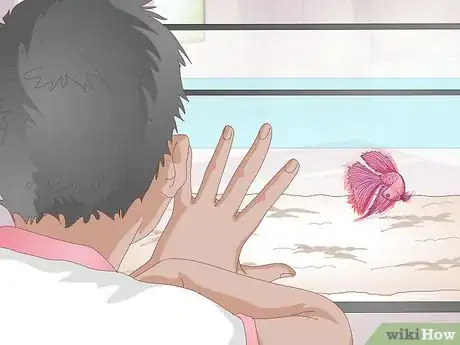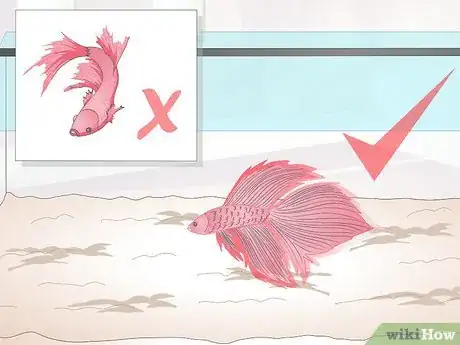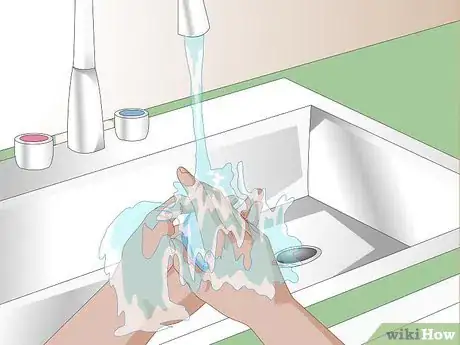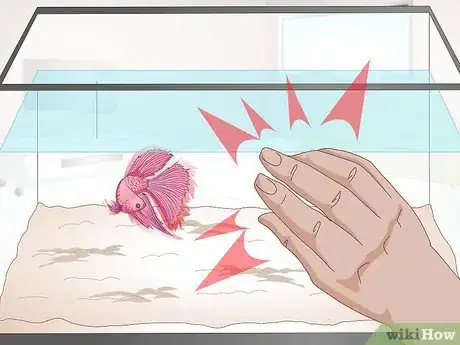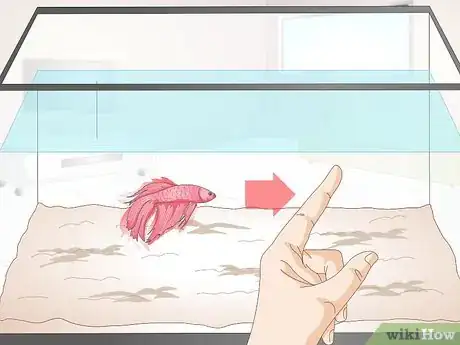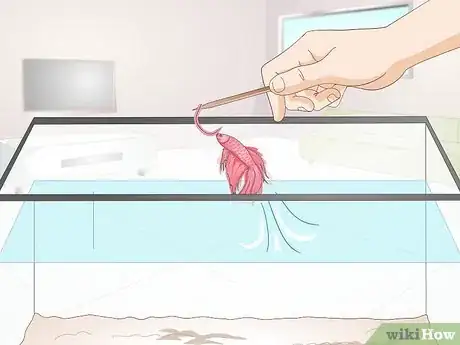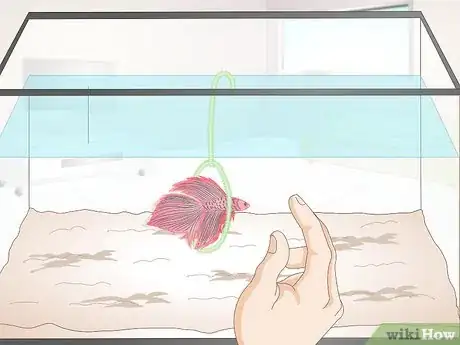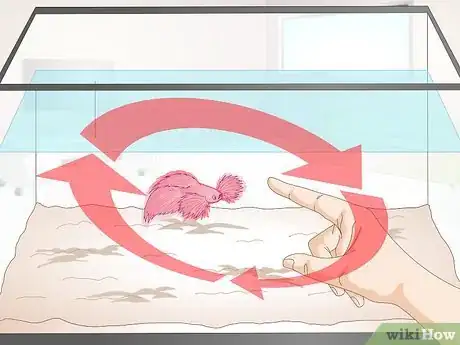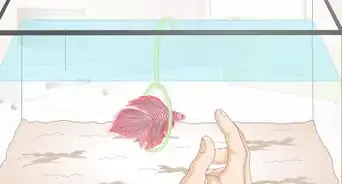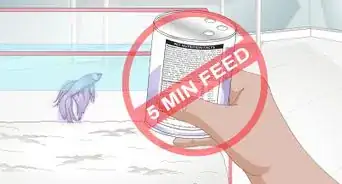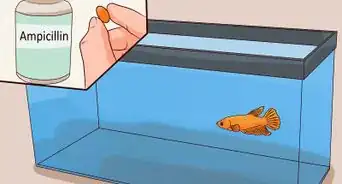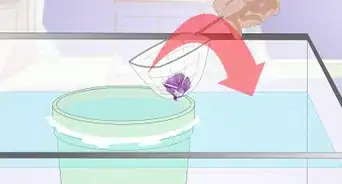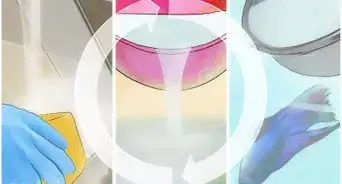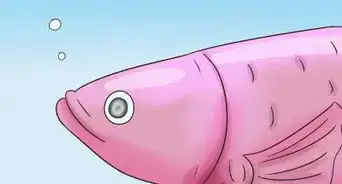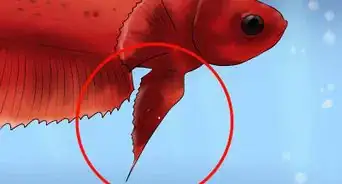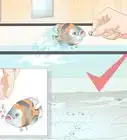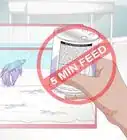This article was co-authored by Pippa Elliott, MRCVS. Dr. Elliott, BVMS, MRCVS is a veterinarian with over 30 years of experience in veterinary surgery and companion animal practice. She graduated from the University of Glasgow in 1987 with a degree in veterinary medicine and surgery. She has worked at the same animal clinic in her hometown for over 20 years.
There are 7 references cited in this article, which can be found at the bottom of the page.
wikiHow marks an article as reader-approved once it receives enough positive feedback. This article received 24 testimonials and 92% of readers who voted found it helpful, earning it our reader-approved status.
This article has been viewed 361,740 times.
The Siamese fighting fish, or betta fish, fights other fish in nature. Although bettas prefer to live alone, they will play with you if you train them. Start by training your betta to follow your finger. Once your fish has mastered this skill, you can teach her more tricks like jumping or flaring. Learning tricks will help your betta fish to avoid boredom and receive exercise.
Steps
Preparing to Train Your Betta
-
1Get to know your betta. Although it might surprise you, betta fish can recognize you. They actually can become attached to their owners. If you spend time near your fish, they are more likely to recognize you. This will help in training. If you have just acquired your betta, give it at least a week to recognize you. You will know that your betta is ready if he or she starts swimming towards you if he/she sees you.
-
2Check your fish's well-being. Make sure your fish's color is bright and clear. It's fins should have no tears or holes. The scales should be smooth. Your fish should not move in a sluggish manner. Instead, they should swim quickly. Bubbles on the water's surface are a good sign that your betta has reached sexual maturity, it does not mean that they are happy.[1] If you want to train your betta, they need to be in top condition.Advertisement
-
3Gather snacks for training. Purchase snacks like freeze-dried bloodworms for your pet. These are good training treats because they are breakable and small, although do not over feed these, they are basically potato chips to a betta, little to no nutrients in freeze dried foods. Frozen foods, however, are very good for bettas. Bettas also eat tubifex worms, mosquito larvae, and daphnia (small crustaceans).[2] While treats and food are great for training, overfeeding your betta is dangerous. A full-grown adult male betta should eat maximally two to three pellets or three to four bloodworms per feeding. He should be fed twice daily.[3]
- If your fish's body is swollen, cutback feeding. They could be constipated. You can detect constipation by looking at the fish's digestive area from the side. If it is swollen, they likely are constipated. You also might notice a lack of defecation. If this happens, do not feed her for two days. #*Be sure to thaw frozen food before use.[4]
-
4Wash your hands. Before you work with your fish or are near her tank, wash your hands. Use hot water but do not use soap. Soap is toxic for fish. When you finish a training session, wash your hands with soap.
-
5Get your betta's attention. Softly tap on the glass and see if they look at your hand. If not, give them half a worm or a treat to get their attention. Once they focus on your hand and their gills move quickly, you can begin training.
- Do not tap very hard or hit the tank repeatedly. You will shock your fish.
Training Your Betta
-
1Teach your fish to follow your finger. Drag your finger across the front of the fish tank (never keep a betta in under five gallons, it is unethical and cruel). If they move towards it, reward them quickly with a treat. If they do not notice you, shake your finger until they notice.[5] Move your finger in multiple directions. First, move your finger to opposite sides of the tank. Next, move your finger vertically up and down. Reward your fish each time they follow you.[6]
- Train them for three to five minutes at a time over several days. Proceed to other tricks once they consistently follow your finger.
- Once your betta can follow your finger, teaching other tricks will be easier.[7]
-
2Train your betta to flare on command. When a male betta sees another male in nature, he flares. Flaring consists of a betta stretching her fins and opening their gills as much as they can. Bettas then look twice their size. You can teach your male or female fish to do this pretty trick. Flaring provides exercise, prevents boredom, and promotes bubble nest building. Bubble nest building consists of male bettas methodically blowing small bubbles in clusters on the water's surface.[8] Only perform the flare trick three to five minutes a day or you can overexert your betta. Follow these steps:
- Gather a small mirror and a red or black-capped pen. Use the same colored pen throughout training so your betta will recognize the pen.
- Place the mirror in front of the tank.
- Once your betta flares, place the pen next to the mirror.
- Repeat this process two to three more times.
- Sometimes your betta will get afraid, and may move away. Keep on trying.
- Once your betta instantly starts to flare, remove the mirror and leave only the pen.
- Give your betta food or a treat each time they flare.
- Continue until your betta flares each time you show the pen.[9]
-
3Teach your betta to jump. Jumping is a natural habit for betta fish. To train your betta, use a feeding stick and place half a bloodworm on it. The food should be within reach of the fish. Starting with the stick underwater, have your betta come to you. With the next try, move the feeding stick closer to the water's surface. Have your betta swim to you. Then move the stick to the water's surface. Your betta should swim to you. Lastly, move your stick slightly above the water surface. Once your betta recognizes that they can get food from the stick, they will jump for it even if the stick is out of the water. After they nail the trick, you can substitute your fingers for the stick. This trick may not be recommended as you will need a lid for if they jump, so if they think jumping gets them food, then bam, you have a betta that always jumps and may get out of the tank and die.
- By halving your bloodworms, you can avoid over-feeding your betta. Remember, they should have a maximum of three to four bloodworms in one sitting.[10]
- You can train your betta to recognize a feeding stick, a thin stick with a curved end for attaching food, during their normal feeding times.
- Bettas naturally jump when water conditions are not good. Purchase a lid for your fish tank to prevent your betta from jumping from the tank.[11] They can still jump when you remove the lid to feed them.
-
4Train your betta to swim through a hoop. Gather a pipe cleaner. Bend the pipe cleaner into a circle with a two inch diameter. Hang it on the side of the fish tank. The hoop should be perpendicular to the side of the aquarium and touching it. Move your finger along the outside of the tank in one direction through the hoop. Each time they swim through the hoop, give them a treat. Repeat this process until they regularly swim through the hoop. Gradually decrease the hoop size until it is slightly larger than one inch in diameter. After they are comfortable with the trick, move the hoop farther away from the tank's sides. Continue until they can swim through the hoop while you hold it in the center of the tank.
- This is one of the most difficult tricks so do not be discouraged if it takes a while.
- Be sure that your pipe cleaner is brand new and does not contain toxins that could harm your fish.
-
5Keep trying! Your betta will eventually figure out that if they do what you ask, you will reward them. Do a training session once per day. Be persistent.[12] Do not overwork your betta, though. Make sure they have sufficient time to rest and relax. Do not force your fish to play if it doesn't want to. They don't exist just for entertainment.
Expert Q&A
Did you know you can get expert answers for this article?
Unlock expert answers by supporting wikiHow
-
QuestionI bought a new Betta fish. When should I start training?
 Pippa Elliott, MRCVSDr. Elliott, BVMS, MRCVS is a veterinarian with over 30 years of experience in veterinary surgery and companion animal practice. She graduated from the University of Glasgow in 1987 with a degree in veterinary medicine and surgery. She has worked at the same animal clinic in her hometown for over 20 years.
Pippa Elliott, MRCVSDr. Elliott, BVMS, MRCVS is a veterinarian with over 30 years of experience in veterinary surgery and companion animal practice. She graduated from the University of Glasgow in 1987 with a degree in veterinary medicine and surgery. She has worked at the same animal clinic in her hometown for over 20 years.
Veterinarian
-
QuestionI tried to move my finger but he doesn't follow. What's wrong?
 Pippa Elliott, MRCVSDr. Elliott, BVMS, MRCVS is a veterinarian with over 30 years of experience in veterinary surgery and companion animal practice. She graduated from the University of Glasgow in 1987 with a degree in veterinary medicine and surgery. She has worked at the same animal clinic in her hometown for over 20 years.
Pippa Elliott, MRCVSDr. Elliott, BVMS, MRCVS is a veterinarian with over 30 years of experience in veterinary surgery and companion animal practice. She graduated from the University of Glasgow in 1987 with a degree in veterinary medicine and surgery. She has worked at the same animal clinic in her hometown for over 20 years.
Veterinarian
References
- ↑ http://www.petful.com/misc/tips-for-raising-betta-fish/
- ↑ http://pets.petsmart.com/guides/betta-fish/caring-for-betta.shtml
- ↑ http://nippyfish.net/sick-betta/bloating-and-constipation/
- ↑ http://www.petco.com/assets/caresheets/fish/Betta.pdf
- ↑ http://bettacare101.com/tricks/
- ↑ http://bettacare101.com/tricks/
- ↑ http://bettacare101.com/tricks/
- ↑ http://nippyfish.net/behavior-2/bubble-nests/
- ↑ http://bettacare101.com/tricks/
About This Article
To train your betta fish, drag your finger across the front of the tank and reward your fish with a bloodworm treat when it follows your movements. Next, train your betta to jump by placing half a bloodworm on a feeding stick, moving the stick closer to the water’s surface each time until the fish jumps for the treat above the water's surface. You can also train your betta to swim through a pipe cleaner hoop using treat rewards! For tips on training your betta to flare, read on!
